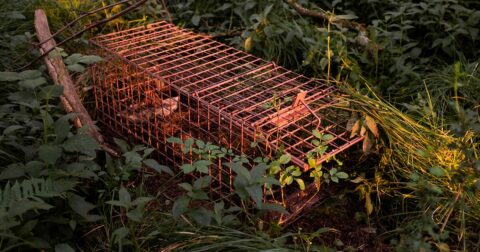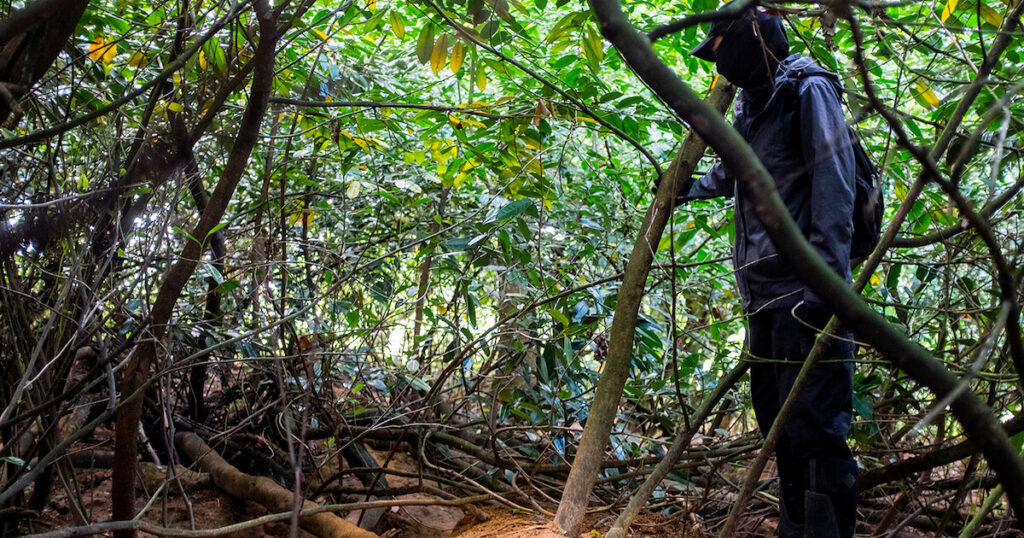News
Slaughterhouses Harbor Antibiotic-Resistant Bacteria That Give People Urinary Tract Infections
Food•6 min read
Feature
In 2021, 33,687 badgers were killed to protect cattle from the spread of Bovine Tuberculosis. By 2025, 140,000 more badgers could die.


Words by Aidan Frere-Smith
New documents released this week reveal that a total of 33,687 badgers were killed in intensive and supplementary culling zones throughout the United Kingdom in 2021.
This comes after a recent report found that “badger culling can make no meaningful contribution to the control of Bovine Tuberculosis (bTB) in cattle.” The research, published by the British Veterinary Association, analyses the impact of culling during the most pivotal years in the UK government’s Bovine TB Eradication Program.
The report compared the incidence and prevalence of bTB in both culled and un-culled areas and found that, though the disease peaked and began to decline, there was no statistical evidence to link the rise and fall of bTB to the culling of badgers. The new data reaffirms, despite what local farmers would lead us to believe, that managing bTB does not require any badgers to die and instead should focus on better monitoring systems for cattle.
BTB re-emerged in cattle in the UK in the 1970s, and badgers initially were believed to be the cause of the problem as they, among other wild animals, are capable of carrying the disease. The culling of badgers began in 2013, with support for the new measure led by the National Farmers Union and pro-badger culling group, TB Free England. The culls have continued, relatively unabated, for almost a decade. But they have been the subject of a highly contentious debate. While farmers see the culls as a necessary preventative measure, advocates and academics believe the badger cull is another chapter in a long history of badger persecution, dating back to the 16th century. Such persecution led to legislation protecting the species, while the cull continues today.
Under the Protection of Badgers Act 1992, it is illegal if someone “wilfully kills, injures or takes, or attempts to kill, injure or take, a badger.” This legislation also makes interfering with badger sett a criminal offense, including damaging or blocking access to entrances. Badgers reside underground in a network of tunnels with multiple entrances known as a sett. Causing damage to or blocking an entrance to a sett is a criminal offense. However, culling badgers can still be sanctioned through a license.
Culling operates under two licenses. Intensive culling is carried out over six weeks, though sometimes extended. The vast majority of badgers in a given area are killed within this timeframe. Supplementary culling, which follows after a four-year intensive license, operates from June to January. Supplementary culling licenses generally have a lower quota and are carried out over five years.
The plight of the badger becomes more severe with every new license issued. The government-led persecution of one of Britain’s most iconic mammals, however, is nothing new.
Following the emergence of bTB in Gloucestershire and Cornwall in 1971, the government sanctioned the gassing of badgers two years later. Though there is no official data on how hydrogen cyanide was used on the badgers, Dr. Richard Meyer estimates in his book The Fate of The Badger that it is likely to be somewhere around 15,000.
In 1980, a commissioned report continued to blame badgers for the spread of bTB in cattle. Though the gassing of badgers was officially abandoned in 1981, culling resumed under a “clean ring strategy.” Badgers around infected farms were sampled and, if a single badger tested positive, a whole sett would be culled. This method continued for five years.


After more than a decade of killing badgers, the legitimacy of culling was officially being challenged. In 1986, a report found that the incidence of bTB in cattle had gone down, but this decline was not related to shifts in badger populations and that it is likely “that in many parts of the country, infected badgers can exist with an extremely low probability of transmitting the disease to cattle.” His conclusion wasn’t enough to abandon culling altogether. It did, however, recognize serious issues within animal agriculture, admitting that “undoubtedly cattle are moved without the legally required record of movement” and recognized “that not all carriers of [mycobacterium bovis] will be identified at post mortem examination.”
A new interim strategy was implemented in 1986. Though badger culling continued, farmers were beginning to be held accountable for their own biosecurity measures, which, when introduced correctly, reduced the amount of contact between badgers and cattle.
In 1997, a third review of bTB was published. The report stated badgers were a “significant source of infection in cattle” but concluded that the evidence was “indirect” and thus inconclusive. The following year, the Department for Environment, Food & Rural Affairs (DEFRA) launched The Randomised Badger Culling Trial to investigate how bTB spreads among cattle, badgers, and other wildlife. The Independent Scientific Group on Cattle TB (ISG), which oversaw the trial, published its results and concluded that “badger culling cannot meaningfully contribute to the future control of cattle TB in Britain.” The report also states that, between 1998 and 2006, 10,979 badgers were culled.
The DEFRA report caused problems in political circles. Sir David King, the UK Government’s Chief Scientific Adviser of the time, counteracted the ISG in a report that he produced in less than six weeks. His position was clear: “Removal of badgers is the best option available at the moment to reduce the reservoir of infection in wildlife.”
Criticisms of King’s report were published by the scientific journal, Nature. They voiced concern that “it is likely that political factors will ultimately overrule scientific ones when a government takes a decision in a contentious field.” This fear would become a reality.

The following year, Hilary Benn, then-Secretary of State for Environment, Food and Rural Affairs, announced his rejection of badger culling and highlighted other measures that could be taken, including a £20m investment into an effective vaccine for cattle and badgers. Frustrated with the prospect of farmers and landowners taking responsibility, the National Farmers Union (NFU) stated that this “will be a devastating blow for farmers and their families that are really being blighted, devastated and destroyed.” They then launched a vicious media campaign in support of badger culling, which included a provocative image of a slaughtered cow with the headline: “She needed indecision on TB like she needed a hole in the head.”
For years, politicians and industry groups continued to push badger culling. In 2010, Elin Jones, then Welsh Rural Affairs Minister, proposed culling to take place in parts of Pembrokeshire and Ceredigion as part of her commitment to “tackling the bovine TB crisis.” Following a three-month consultation, the proposed culling was abandoned as “the reductions in cattle TB incidence achieved by repeated badger culling were not sustained in the long term,” according to a research report.
Despite continued skepticism, the Secretary of State for DEFRA, Caroline Spelman, announced in 2011 the UK Government’s plan to cull badgers. DEFRA later confirmed that the pilot scheme would take place in Gloucestershire and Somerset in 2012. However, the cull was delayed for a year by Environment Secretary Owen Paterson. It was claimed that this was due to “time-consuming legal challenges to the cull” and “insufficient” police resources.
Regardless of the delay, the culling of badgers was once again inevitable. Activist-led opposition to the cull moved from lobbying and campaigning to direct action. In 2013, Gloucestershire police, in preparation for policing the cull, confirmed this to be a ‘big concern’ and admitted that they would “bend the rules” to maintain public safety. A high court injunction was also that year imposed but had little effect as many anti-cull activists claimed their efforts to be successful. That same year, the cull failed to meet the government’s own quota.

Somerset and Gloucestershire culling zones had targets of culling at least 70 percent of their badger populations within six weeks, starting in September. Following the cull, however, a report by the Independent Expert Panel found that Somerset only reached 48 percent of its culling goal and Gloucestershire 39 percent. The report concluded that of the 1573 badgers culled, up to 22 percent could have taken up to five minutes to die in pain.
In a desperate attempt to meet the quota for the Gloucestershire zone, the pilot cull was extended for eight weeks but was abandoned after three after “marksmen failed to kill enough animals to meet even drastically reduced targets.” The Somerset zone fell short of the minimum target by 5 percent while Gloucestershire was short by 30 percent, according to a government report.
The following year, Paterson announced the pilots would be continued in the same areas, but organizers faced similar problems meeting their quotas. In DEFRA’s report, it suggested that these low numbers were due, once again, to the efforts of anti-cull activists. In Gloucestershire, DEFRA was met with “widespread interference.”
Both pilot culls cost UK taxpayers £9.8 million, the equivalent of over £5,200 per badger killed.
Before the election in 2015, secretary of state for DEFRA Elizabeth Truss, confirmed her position on the badger culls. “We will not let up, whatever complaints we get from protesters groups. We are in it for the long haul and we will not walk away,” she stated. True to her words, following the election of a Conservative government, new documents confirmed that culling would continue in Somerset and Gloucestershire with an additional license issued in Dorset.
For the first time since the annual badger culls began in 2013, the quota was met in each zone. All told, 1467 badgers had been killed, according to a DEFRA report. Truss went on to state that while the zones “all hit their targets,” she was considering extending the program. Her consideration was an understatement.
In 2016, ten zones were given licenses for culling, with Herefordshire, Cornwall and Devon added to Gloucestershire, Somerset and Dorset. In the years that followed, the cull grew exponentially. In 2020, 43 zones were issued licenses for intensive culling, and an additional 10 licenses were given out for supplementary culling zones.
Between 2013-2020, 143,241 badgers have been killed in cull zones, according to Badger Trust.

In 2021, DEFRA announced that the national badger cull was coming to an end. According to a press release, no new licenses would be authorized after 2022. As an intensive culling license runs for 4 years, this meant that any new licenses authorized in 2022 would continue until 2026. Though this announcement gave a glimpse of hope for the plight of the badger, the reality is that the badger cull would be expanded. And it did.
In the same year, new cull licenses were authorized across the country. With an additional 7 intensive zones and 11 supplementary zones added, culling took place in a total of 61 zones. A total of 33,687 badgers were killed across intensive and supplementary zones.
If the government is true to its word, 2022 will be the last year to apply for a license to intensely cull badgers. In February, the government held online consultations allowing the public to comment on applications made for new intensive culling licenses. The following month, another consultation was also had. Though the number of zones and their specific location were not given, DEFRA stated that the applications for new culling licenses were spread across eight counties. Whether or not these licenses are authorized, the coming years look bleak for UK badgers. The Badger Trust estimates that another 140,000 badgers could be killed by the end of 2025.